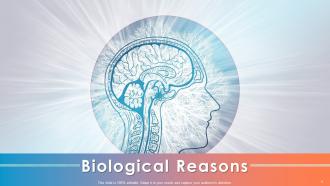Diversity and inclusion training biological on reasons behind bias formation edu ppt
This module contains information about the multiple biological reasons that make humans biased. It highlights the brains functioning, such as seeking patterns and taking shortcuts that lead to bias formation. Also, it covers the details of the Amygdala in the Limbic System of the human brain, which is responsible for emotional responses in humans. Further, it highlights the role of the Automatic Nervous Systems components, i.e., the Parasympathetic Nervous System and Sympathetic Nervous System that controls different body reactions towards situations.
You must be logged in to download this presentation.
 Impress your
Impress your audience
Editable
of Time
PowerPoint presentation slides
Presenting Diversity and Inclusion Training on Biological Reasons Behind Bias Formation. This presentation deck contains well researched and uniquely designed slides. These slides are 100 percent made in PowerPoint and are compatible with all screen types and monitors. They also support Google Slides. Premium Customer Support available. Suitable for use by managers, employees and organizations. These slides are easily customizable. You can edit the colour, text, icon and font size to suit your requirements.
People who downloaded this PowerPoint presentation also viewed the following :
Content of this Powerpoint Presentation
Slide 2
This slide provides information regarding the biological reasons behind the formation of bias in humans such as brain functioning that involves seeking patterns and taking shortcuts.
Instructor’s Notes:
- Brain Functioning:
- Seeking Patterns: Bias occurs because the human brain is conditioned to seek the pattern, to form inferences of events happening around them
- Taking Shortcuts: Also, as the human brain has a limited capacity to process all the information it is bombarded with, it forms the mental shortcuts to make it quicker and easier to process the input information effectively
Slide 3
The slide provides information regarding the limbic system of the human brain. It also contains details regarding the working of the Amygdala, which leads to bias formation.
Instructor’s Notes:
- Limbic System: It is the part of the brain that primarily deals with the following three functions:
- Emotions
- Memories
- Arousal
- Amygdala: It is made of two almond-shaped structures in the limbic system. Its major functions are:
- Memory development of emotional and emergency events
- Retaining developed memories for future reference
- Preparing the body to deal with the emergency
Slide 4
This slide provides information regarding the parasympathetic nervous system and sympathetic nervous system in humans. It also covers details regarding the functions of PNS and responses of SNS in the human automatic nervous system.
Instructor’s Notes:
- Automatic Nervous System: It is a control system which acts unconsciously and regulates bodily functions, such as the heart rate, digestion, respiratory rate, pupillary response, urination, and sexual arousal
- Parasympathetic Nervous System (PNS) Functions:
- Salivation: Production of saliva to digest food
- Lacrimation: Making tears to lubricate and preserve eye tissues
- Urination: Contraction of bladder to ensure that urine comes out of body
- Digestion: Stimulates release of saliva
- Defecation: Contraction of intestine muscles (sphincter) to push digestive food to digestive tract for bowel movement
- Sympathetic Nervous System (SNS) Responses:
- Increase heart rate
- Dilation of the pupils
- Secretion of sweat glands
- Dilated muscles
- Increased alertness
- Slowing down or stopping digestion
- Relaxation of the bladder
Additional Slide 1
This slide contains icons related to Diversity and Inclusion in the same color theme that can be used by you to provide additional information of your own.
Additional Slide 2
This slide can be edited by anyone to provide information about your organization. The slide is using the same color theme and similar design elements as the main deck.
Additional Slide 3
This slide contains editable 30-60-90-day plan and is completely editable to suit presenter’s needs.
Additional Slide 4
This slide contains a roadmap template which you can edit to communicate your roadmap in an impactful way.
Additional Slide 5
This fully editable slide contains Activity Calendar for Diversity & Inclusion activities that you can plan for your teams.
Additional Slide 6
This fully editable slide contains timelines for your plan around implementing Diversity & Inclusion agenda in your organization.
Diversity and inclusion training biological on reasons behind bias formation edu ppt with all 11 slides:
Use our Diversity And Inclusion Training Biological on Reasons Behind Bias Formation Edu Ppt to effectively help you save your valuable time. They are readymade to fit into any presentation structure.
-
Good research work and creative work done on every template.
-
Great quality slides in rapid time.
-
Helpful product design for delivering presentation.






























